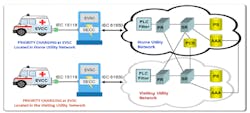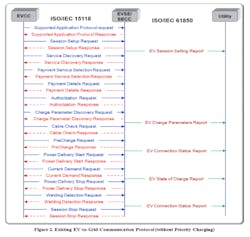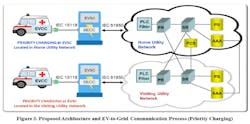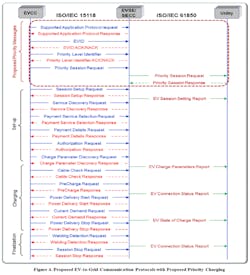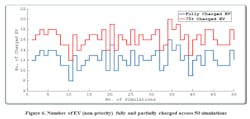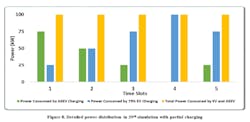Preferential Charging for Government Authorized Emergency-Electrical Vehicles
The proliferation of electrical vehicles (EVs) is exponential. However, the power grid is unable to provide simultaneous charging of several EVs because of limited power production capabilities and old distribution infrastructure. Scheduled charging is one of the most advocated solutions, but it is not viable for emergency vehicles.
Bloomberg predicts the sales of electric vehicles (EVs) to increase from 1.1 million worldwide in 2017 to 11 million in 2025, and then to surge to 30 million in 2030. Only a 10% EV penetration may cause new unacceptable power peaks. The power grid may not be able to handle the new peaks because of its power production capabilities and inadequate distribution infrastructure.
To deal with the problem, studies have proposed to adopt “smart charging” strategies for shifting the peaks to the valleys using techniques such as time-of-use rates, decentralizing EV charging, and real-time scheduling. Among these, real-time scheduling techniques are most effective. However, these are viable for common EVs and not for emergency EVs which cannot sit on the schedule for their turn, because they have to tackle emergency situations. This necessitates a solution that will be able to provide “priority charging” to the government authorized emergency-electrical vehicles (GAE-EVs). This article provides a complete solution, that includes architecture as well as the protocols for enablement of such a service.
Two ideas seemed similar to our solution on the surface but the core concept was quite different. In one, the fleet manager of a company implements priority charging to ensure vehicle availability to his drivers in the local facility. It is more of a manager’s policy-based solution, rather than a technology-based one. In the other, the parking lot owner implements priority-based charging of EVs in a parking lot. In this approach, the EVs with excess capacity are discharged to assist in charging the other EVs in the parking lot, bypassing the utility company. Then these discharged vehicles are charged back based on the customer’s pick-up time priority. However, the approach in not practicable if the customer changes his mind and arrives early to retrieve his car, and feels upset to find that his EV battery was depleted to assist in charging other EVs.
In contrast, we propose a fully automated, nationwide, communication network-based architecture to provide priority charging for GAE-EVs.
Existing Model and Communication Protocols for EV Charging
Figure 1 shows the existing model for EV communication and charging. It consists of four main entities:
- Electric Vehicle Charger Controller (EVCC): Integrates with vehicles' CAN BUS for battery management.
- Electric Vehicle Supply Equipment, aka Charging Station (EVSC): Supplies electric energy to charge EVs.
- Supply Equipment Communication Controller (SECC): Located in the EVSE that controls communication with the utility.
- Authentication, Authorization, and Accounting (AAA): Provides authentication, authorization, and accounting.
Figure 1 also depicts that the EV makes a physical connection to the EVSE over a charging cable using ISO/IEC 15118. The EVSE communicates with the utility over powerline communications (PLC) using ISO/IEC 61851. Figure 2 shows the message sequence for EV charging.
Architecture and Modified Communication Protocols for Priority Charging
Figure 3 presents a comprehensive block diagram of a proposed architecture that introduces several new functional entities and new interfaces. Figure 4 proposes the amendments to ISO/IEC 61850 and ISO/IEC 15118 protocols to support the proposed priority charging service for GAE-EVs. Both the figures are self-explanatory.
Deployment and reliability
Utilities will play an important role in the deployment and operation of EV-charging infrastructure. The utility’s involvement in the actual charging activity may reduce over the time, but its revenue stream will sustain through providing electricity service to third-party owned EV-charging stations. Further, to ensure adequate, safe, efficient, interoperable, and reliable EV-charging services, utilities will be required to meet the expectations of North American Electric Reliability Corp. (NERC) and Federal Energy Regulatory Commission (FERC).
Compliance and adoption
In the telecommunication sector, commercial telecommunication companies provide priority telecommunications services to national security and emergency personnel enabling them to communicate with one another during disasters. The service is led by the Office of Emergency Communications (OEC), Department of Homeland Security (DHS). It has been successfully used during large scale events and emergencies, such as the Super Bowl and the Boston Marathon bombing. With the same token, utility companies will provide reliable priority charging services to national security and emergency personnel, allowing them to charge the emergency EVs, locally or across jurisdictions, especially during the peak hours or crises. The service may also be administered by the OEC.
Simulation Setup and Results
This section explains the simulation for priority charging for GAE-EVs. For this, we first planned the source availability versus load distribution. We assumed a small subdivision with a 250-kVA distribution transformer that serves 40 to 50 houses with an average load demand of 2 kW/house, a hospital with 36 kWh, and a police/fire station with a collective demand of 14 kWh, 24x7. If the 250-kVA transformer operates at 0.92 power factor lagging, it can provide 230 kW of power to consumers in its jurisdiction. On typical evenings/nights, when EVs need charging, the collective residential power demand from say, 40 houses, at the rate of 2 kW per house, reaches: 80 kW + 50 kW = 130 kW (where 50 kW is for ancillary services mentioned above).
The remaining power which the distribution transformer can safely handle for EV charging is 100 kW. If we assume a Level 2+ home charger and that a single EV, on average, has a power demand around 25 kW when charging, it takes about three hours to charge four vehicles, or about a 12-hour night to charge 16 vehicles with scheduling (that is, a batch of four vehicles/three-hour timeslot in four timeslots).
In this subdivision with 40 houses and approximately 32% EV penetration, the number of EVs maybe 18 to 21. Let us assume, out of these EVs, the GAE-EVs that require priority charging are two are ambulances, one police car, one fire engine, and one to two cars belonging to the executive leadership and policy makers. These EVs receive priority charging upon authentication/authorization, as explained in figure 4.
Priority charging may be implemented in two models:
(a) Continue to charge all EVs (including priority and nonpriority) up to 100% and deny charging to some or all of the nonpriority vehicles depending on the number of contending GAE-EVs at that time,
(b) Partly charge all the EVs (including priority and nonpriority) up to say, 80%, 75%, or 70% and so forth, with best efforts to not deny charging of any nonpriority vehicles.
We have created an algorithm and conducted simulations for both the models. In case of option (a), we observe that in the worst-case scenario, four nonpriority EVs are denied charging. In case of option (b), we observe that downgrading the charging level (for example, up to, 80%, 75%, or 70%), results in increased number of EV-charging slots. Thus, GAE-EVs are charged on a priority basis, with no nonpriority EVs being denied. Based on these observations, we recommend option (b).
The result of 50 simulations that represent 50 charging evenings, has been given in Figures 5 to 8. Figure 5 shows the pattern of GAE-EVs requesting priority charging for 50 consecutive evenings. Simulation No. 34 shows that the number of GAE-EVs requesting priority charging is zero. It reflects a realistic situation, as might happen once in a while. Also note simulation No. 10 shows eight GAE-EVs (six nonroaming GAE-EVs and two roaming GAE-EVs).
Figure 6 shows the pattern of GAE-EVs requesting charging for 50 consecutive evenings for both the models “a” (that is, full charging option — blue graph) and “b” (that is, partial 75% charging — red graph). The graphs show that the total number of vehicles charged for mode “b” (red) is more than that of mode “a” (blue). This is because, by enforcing partial charging, an additional slot can be created in which those EVs can be charged that were denied in full charging mode.
Figures 7 and 8 show the number of timeslots versus power distribution for full and partial charging modes. One can see that, for 100% charging mode, four nonpriority EVs are denied charging, whereas by degrading the charging level to 75%, the number of EV-charging slots are increased, and thus GAE-EVs are charged on a priority basis, with no nonpriority EVs being denied.
Statistical Significance
The simulation results are of statistical significance, as all the parameters used for designing the simulations were based on well-established facts and industry best practices. Results reveal some interesting facts. For example, simulation No. 34 in Figure 5, shows the number of GAE-EVs requesting priority charging is zero, revealing that once in a while there might not be any GAE-EV requesting priority charging.
Similarly Figure 6 shows results of 50 simulations for two models:
(a) Charge all, priority and nonpriority vehicles up to 100% charging level, and deny charging some or all additional nonpriority vehicles depending on the grid’s real-time supply status,
(b) Charge all, priority and nonpriority vehicles up to 70% to 80% charging level with the best effort to not deny charging of any additional nonpriority vehicles.
We found that in case of option (a), four nonpriority EVs are denied charging, whereas in case of option (b), no nonpriority EVs are denied charging. This simulation outcome not only provides valuable statistical significance to the utility companies and the policy makers but also validates the proposed concept of priority charging.
Conclusion
The article proposes priority charging for GAE-EVs, presenting a complete solution, including new architecture and amendment in protocols for providing priority charging for GAE-EVs. A major functional entity in the proposed architecture is the priority-charging server, a database server where AE-EV IDs are registered and their record is maintained. We also suggest amendments in the IEC 61850 and IEC15118 protocol suits to enable communication between EVs and the grid. Our solution considers a roaming scenario, that is, a priority-charging request is originated by an AE-EV from a home utility network, as well as a nonroaming scenario, that is, a priority-charging request is originated from a visiting utility network. The simulations performed in MATLAB show that the proposed scheme ensures that most nonemergency EVs are accommodated while giving priority to GAE-EVs.
Acknowledgement
The simulations included here are done by Fahd Ali Shifa, assistant professor, COMSATS Islamabad, Pakistan, under Dr. Raziq Yaqub’s supervision.
About the Author
Raziq Yaqub
Dr. Yaqub is an associate professor in the Department of Electrical Engineering and Computer Science, Alabama A&M University. He is also supervising the research activities of Amphenol-Tecvox Corp. as a Director of Global R&D. He earned a PhD in Wireless Communication from Keio University, Japan, and an MBA in Marketing from Fairleigh Dickinson University, USA. He is an inventor of numerous technologies and has filed dozens of patents in Wireless Communication, Smart Grid, and Cybersecurity of Fin-Tech. He received an Inventor of the Year Award 2014 from New Jersey Inventors Hall of Fame. He also received an Innovator Young Faculty Award 2019 from his University. He has served as executive director of Toshiba America Research and as the department head of NIKSUN University, Princeton, NJ, to lead cybersecurity and big data analytics. He has also served as a senior consultant to the State of New Jersey, a spokesperson in 3GPP on behalf of the Department of Homeland Security, an expert inventor with Wells Fargo, and an associate professor at the University of Tennessee, Chattanooga, USA. He is a senior member of IEEE. More about the author can be found here.
